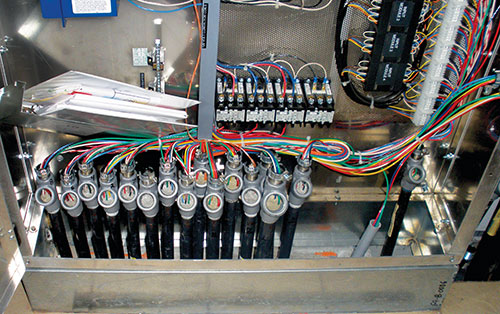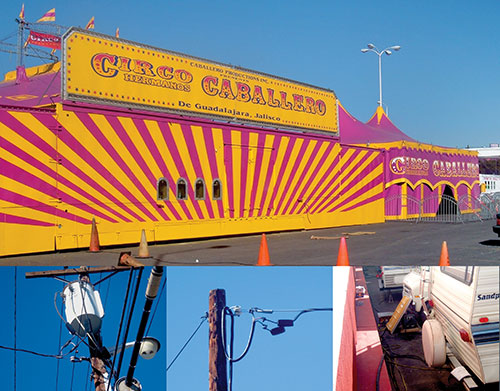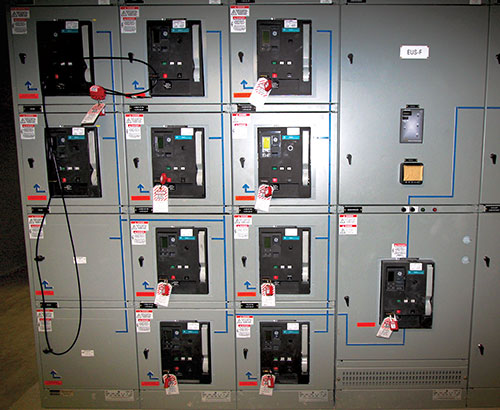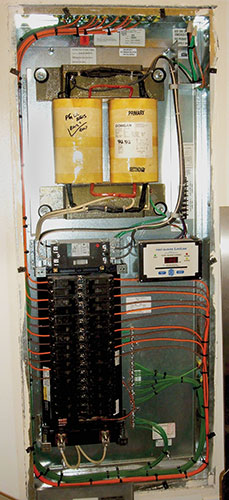Chapter 5 covers Special Occupancies, including areas such as hazardous locations, medical facilities, carnivals, mobile home parks, and more. The difficulty with enforcing chapter five is that we typically don’t see these installations on a daily basis, so we tend not to memorize all of applicable code requirements. A useful technique is to become familiar with the occupancies included in chapter 5, then review a few of the inspection basics that are commonly encountered.
With this in mind, I will share with you the portions of chapter 5 that inspectors will probably see most commonly. As always, I encourage you to get your code book out and follow along to review those areas we skip over in this article. By doing this, you will make yourself more familiar with what is in chapter 5; then you will recall seeing something in chapter 5 regarding aircraft hangers for that one inspection you have at the airport every 10 years or so.
Chapter 5 starts with Article 500, the basic article regarding Hazardous Locations. The code breaks these locations down to three types: Class 1, Class 2 and Class 3, each with a further breakdown into Division 1 or 2. In 500.5, the code describes each location.
In 500.5(B)(1) we find that Class 1, Division 1 locations are where concentrations of flammable gases, or flammable/combustible vapors or liquids are present or may be present in sufficient quantities to produce explosive or ignitable mixtures. The most common example is a gas pump where you fill your vehicles; fumes are continually escaping, and fuel is commonly spilled at these locations.
In 500.5(B)(2) we find that Class 1, Division 2 locations are where the same products are stored and handled but are in containers where they can only escape if there is an accident. A Division 2 location may be one that has approved ventilation to remove any vapors that may be present. Another Division 2 location is generally on the outer perimeter of any Division 1 location; the thinking is that there is a reduced concentration and possibility of danger.
In 500.5(C) we find the Class II locations outlined. In the division 1 locations, we have the presence of combustible dust in the air under normal operating conditions that may ignite or where a mechanical failure will create such a hazard. Examples may be grain dust, some powders, or even metal dust. A Division 2 location would be where an abnormal operation may create a hazard of dust presence in the air, where concentrations are normally not of a volume sufficient to create a hazard but a malfunction could create such a volume, or where accumulations of dust on electrical equipment could become a hazard.
The last location, Class III, is covered in 500.5(D). These are locations where we have easily ignitable fibers. A Class III Division 1 location is where fibers/flyings are handled, manufactured or used. A Class III Division 2 location is where we have fibers/flyings stored or handled other than in the process of manufacture. The best example of this hazard would be a textile factory that makes clothing.
So for review, Class 1 is flammable liquids or vapors; Class II is flammable dust, and Class III is fibers or flyings. Identifying what is in the location (fibers, dust or liquids/vapors) is the quickest way to determine which code section applies. Article 500 continues with a lot more detail that you can review on your own; we’ve covered only the basics that will allow you to identify which hazard you are dealing with.
Article 501 deals with the specific requirements for installations in Class I locations. The wiring method requirements are detailed here, but I will cover only one of the items which is most often mis-installed and not inspected thoroughly. Section 501.15 covers the requirements for sealing fittings at various locations, and the idea is to prevent the migration of dangerous liquids or vapors from a hazardous location to one where we might have a source of ignition. These fittings are commonly called seal-offs and have a very specific location and an installation method to maintain a safe installation. I can’t possibly tell you how many times in my career I have found these seal-offs that have not been located properly, or worse yet, never sealed. The manufacturer’s installation instructions are the proper way to make sure these are sealed properly, and they generally require packing a fibrous packing material into the bottom of the fitting and separating the conductors, so we don’t get a pocket of open space. Once this is done, a compound is mixed and poured into the fitting to a thickness equal to the trade size of the fitting (3/4″ thick for a 3/4 trade size fitting), but never less than 5/8″ thick. Refer to 501.15(C) for these requirements.
The other inspection issue is the location of these sealing fittings; for Class I Division 1 locations, this is covered in 501.15(A)(4) which states that the sealing fitting is allowed within 10 feet on either side of the boundary. For underground conduit runs, the sealing fitting is allowed to be aboveground as long as it is the first fitting used above grade. These underground runs are permitted to be run in PVC; however, where they break grade, they must be in a metallic threaded raceway system. Here is the hitch: remember the sealing fitting is to be the first fitting, which means no unions, couplers or anything else between the grade break and the fitting. I’ve seen inspectors and contractors allow couplers and nipples to be installed, so all the sealing fittings line up at the same height, so they look good, especially where they break grade through a concrete slab on the exterior of a building. This kind of installation is an outright code violation.
How do we inspect the sealing process to ensure we get these installed properly? I required that they make a two-part inspection for the seals; for the first inspection, check the packing material and conductor separation. Then do a second inspection to verify that each unit has had the compound installed. I’ve seen silicone, clay, duct seal, newspaper, and who knows what else, installed in seal-offs; so make sure you do your job and get these fittings inspected properly.
I’ve covered a few basic issues here, but by no means have I covered everything. Please take the time to read the code and increase your knowledge of these requirements.

Next, we will skip to Article 511, Commercial Garages, Repair and Storage. These locations are a fairly common inspection, but we don’t do them every day so we should review a few items. The first thing to determine is if we are doing a major repair or minor repair; these definitions are located in 511.2. A major repair garage is where we are doing repairs such as engine overhauls, paint and body work, and repairs that would require draining the fuel tank. A minor repair garage would be tune-up centers or the minute lube facilities that are commonly seen. As you review Article 511, you will find the information regarding various locations within a facility and how they are classified, such areas as the ceiling, floor, or any pit locations. Now with some of our new alternate fuels, we may have to be aware of locations we haven’t thought about in the past.
The one item I want to specifically point out is 511.12, which triggers the requirement for ground-fault circuit-interrupter protection for all 125-volt, single-phase 15- and 20-ampere receptacles used for servicing and repairing of vehicles. This is a great requirement in my mind, as the cords and equipment used in this type of work are often not in the best repair and may be a danger.
The other item to point out is the Area Classifications in 511.3, specifically (C) and (D). Here you find that if you don’t have the specified ventilation, the receptacles need to be at least 18″ above grade to avoid being in a classified area. What we generally find is that the receptacles are located around 48″ above the floor to make them easily accessible above any work benches that may be installed around the walls of the shop, thus avoiding the classified wiring method requirements altogether.

I also want to point out Article 514 Motor Fueling Dispensing Facilities. Here we find some very helpful items for inspectors. The items I’m referring to are Table 514. 3(B)(1), which puts classification locations into a table form that has always been a help to me and my staff during the years. Also, Figure 514.3 showing classified areas adjacent to dispensers is very useful.
The last item I want to point out regarding fueling locations is found in 514.11(A), this requires a disconnecting means for each circuit and any associated power, communications, data and video circuits feeding out to or through the dispensing equipment (what we commonly call pumps really aren’t pumps, in actuality the pumps are usually remotely installed on the top of the tanks, and the units we actually receive fuel from are only dispensers). This disconnecting means shall be remote from the dispensers in a readily accessible location. We always added language to our local amendments in the Las Vegas area that required consistent signage for these disconnecting means so they were easier to find. Now the catch with this requirement is that it requires the data circuit for the credit card reader, the video signal for the advertising monitor often found on top of dispensers, and any other electrical devices we may find in these locations to be disconnected simultaneously. I understand there are products out there that accomplish this, but to date I haven’t seen these in person.
The requirements for paint spray booths are found in Article 516, and we find a lot of spray locations either in automotive or industrial installations. This is an item where we generally reviewed the actual language of the code each time we had an inspection for one of these locations. When an inspector is looking at several trades and only sees one of these every 3 to 6 months, it is good to break out the code book. There are many different configurations of spray booths, open face and fully enclosed to name a couple. Article 516 has very good illustrations to aid us in enforcement and classification of areas with and around these units. With manufactured spray booths, we usually looked for a listing mark from one of the Nationally Recognized Testing Laboratories, which made our job a bit easier as it meant the wiring methods and light fixtures were already evaluated for the hazardous location.

Let’s move on to Article 517 Health Care Facilities. This is one of those articles that introduce several new locations and requirements. The origin of this article was the concern over flammable anesthetics, which were more commonly used several decades ago. While that hazard has been minimized, we still have issues we must be aware of while doing medical procedures. There are a lot of items in 517, but I will cover only those that I feel will be the most beneficial to the combination inspector.
The first inspection issue is the requirement found in 517.13(A) Wiring Methods and (B) Insulated Equipment Grounding Conductor. The wiring methods paragraph generates the requirement for any installation in a patient care area (as defined in 517.2) to be installed in a metal raceway or metallic cable armor system that qualifies as an effective grounding path. In the next portion (B) we also find that we need an insulated copper equipment grounding conductor. So basically, we have two grounding paths, the raceway/cable assembly and another insulated equipment grounding conductor. This is commonly called a redundant grounding system. This doesn’t sound too hard, right? The issue usually comes when a contractor who doesn’t know the code that well runs PVC under a slab feeding to a circuit in a patient care area. One of the most common locations for this error is dental offices. From our reading in 517.13(A), we don’t find any option other than a metallic wiring method; therefore, the PVC will not qualify. We have had numerous issues with this, and usually the contractor states he’ll pull two Equipment Grounding Conductors. However that is still a code violation, since any raceway installation in a patient care area has to be metallic. When we reject these installations, we see a lot of concrete removal. Here is the real issue: if the contractor had called for the underground inspection prior to the general contractor pouring the floor slab, we would have caught this and helped them get it installed properly the first time.
The next item is 517.17 Ground-Fault Protection. Simply put, these requirements are applied if you have a main service that is required to have ground-fault protection (GFP) elsewhere in the code. If this is the case, then we must have a second level of ground-fault protection in the feeders just downstream of the main. The reason for this is that we don’t want a ground fault from one portion or one tenant in a facility to cause the main to go down and put the entire facility out of power. So providing a second level of protection in each feeder under the main GFP will protect the rest of the facility from a ground fault when they are selectively coordinated as per 517.17(C).
This is usually done correctly in hospitals; the problem often occurs when you have a multi-tenant medical office building. I had an electrical engineer argue with me one day saying he didn’t need to do the second level of protection because the building was just an “office building.” I asked him who drew the plans, and he was proud to say he did. I then asked him why the approved set of plans said “Medical Office Building” on every page. So I told him I would listen to him if the owner of the building would write a letter to the Building Official stating that at no time would he lease any space to a tenant who would open a medical practice. No surprise, that letter was never written, and the required ground-fault protection was added. That facility is about fifteen years old, and to this day it has around a 75% occupancy of medical practices, including surgery suites.
The last item in Article 517 to mention is related to surgical suites, which utilize an isolation panel board. These are designed to minimize the possibility for any electrical exposure to patients who are having a procedure done in the operating room. It is an isolation transformer creating a separately derived system with a 120-volt secondary that is an ungrounded system, preventing any possibility of an arc to a grounded surface or person. Now here is a little bit of knowledge that might make you a hero: if you see one of these isolation panels on your project, let the contractor know that standard thermoplastic insulated wire (THHN/THWN) will not pass the voltage leakage test that must be performed as part of the installation of these isolation panels. In order to meet the voltage leakage test, the wire will have to be a thermoset insulation (XHHW). However, most supply houses don’t stock XHHW in 12 or 10 AWG sizes, especially in the colors required for these systems as per Article 517.160(A)(5), which are brown and orange with a distinctive strip other than green, gray or white. As you can imagine, this will probably be a special order for most supply houses.
If you happen upon one of these, be a friend and a little proactive to help the contractor, with your knowledge of what will be required for a code-compliant installation. You never know, this may just save a few phone calls later on where the contractor complains you are holding up his project because of some code he has never heard of.

Article 525 deals with carnivals, circuses, fairs and similar events. In my career in enforcement, these were often a cat and mouse type of game. A traveling carnival would show up on a Thursday, set up on Friday and open Friday night, and be closed down and traveling to the next town on Sunday night. As such, all too often they never got permits and inspections. The more professional organizations would be organized in such a way that they would get permits and have the proper inspections. We worked closely with our fire department to make sure they were involved to do their inspections, and they would make sure we were included if the carnival didn’t know to get a building permit.
Please take a moment to review Article 525, as there are requirements for clearances and disconnecting means for various pieces of equipment. But the one item I want to make sure you are aware of is the requirements for GFCI protection found in 525. 23. Any receptacles used for disassembly, reassembly, or that are readily accessible to the general public, along with any equipment accessible to the general public that is 125-volt, 15- and 20-amp must have GFCI protection. The issue is that these are assembled and taken apart on a regular basis and may be damaged, creating a shock potential for anyone, so we need to make sure we get proper protection and that the GFCIs are tested and working. The number of cord assemblies used at one of these events can be quite a larger number, so you may need some help getting these inspections done in a timely fashion. Often they schedule the inspection at the last minute before they are due to open, so good luck.

The last item to point you to in Chapter 5 is Article 590, Temporary Installations. This article takes just a little over two pages, but it is one we should all review since every construction project has some form of temporary power installation for the construction crews. The condition of the cords and tools used by the contractors often are not the best, so the one item we should really watch for would be 590.6 Ground Fault Protection for Personnel. This requirement is covered in one entire page, giving several options. In my experience, and for the most compliant and easily maintained system, the best course is simply to make sure 590.6(B)(1) is followed which requires that GFCI breakers or receptacles be used.
We’ve now completed another chapter of the NEC. I have only touched on the few items that I have identified through the years as being often missed, and ones where I’ve seen difficulty in getting code-compliant installations. Several of the items mentioned are those that I’ve seen combination inspectors struggle with, mainly due to how infrequently they see these types of installations. Again, please take the time to review the other portions of the code that we have skipped over in order to get the most benefit from this article.











Find Us on Socials